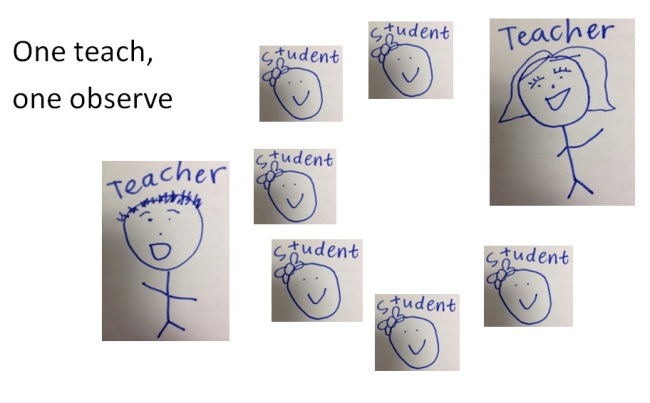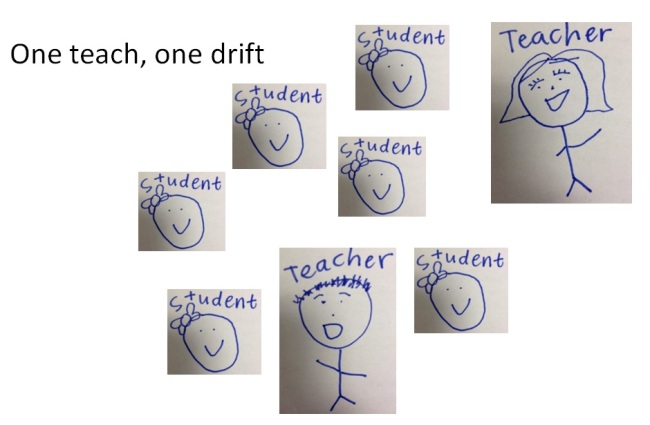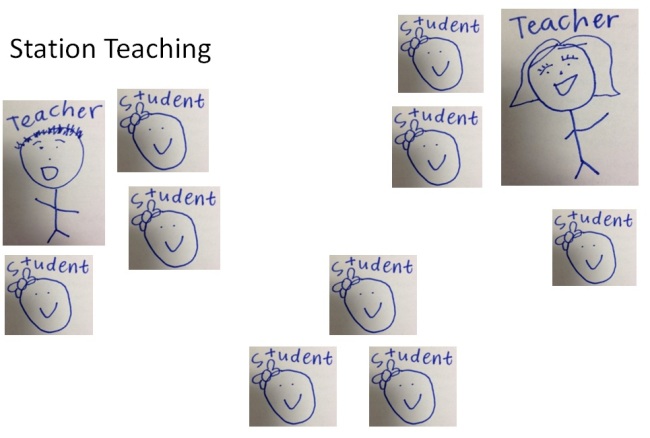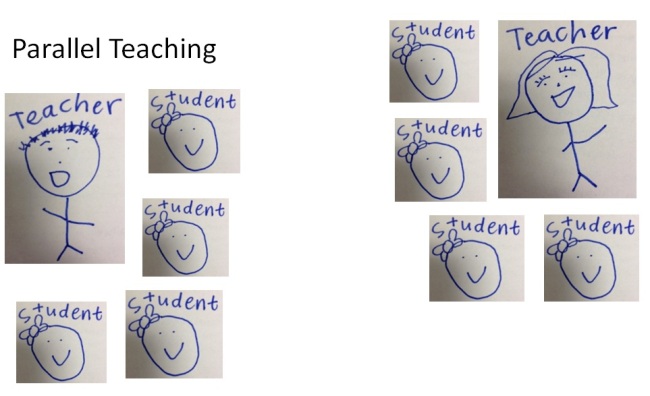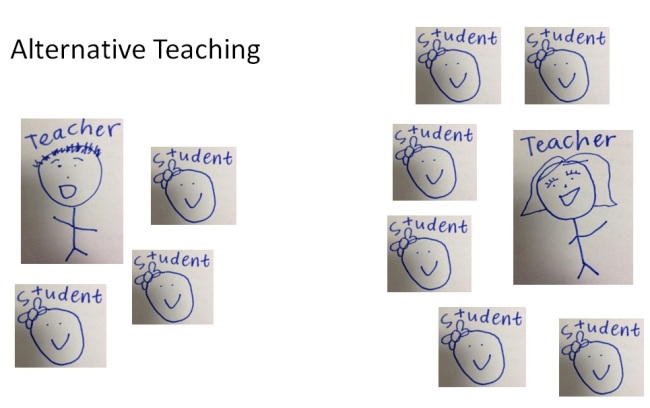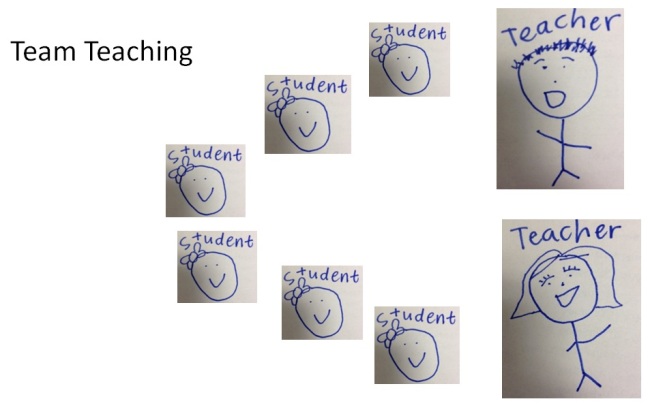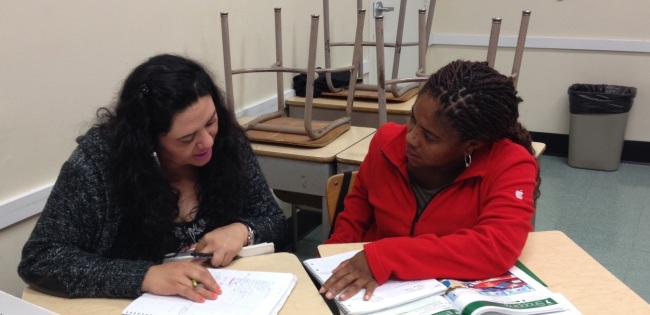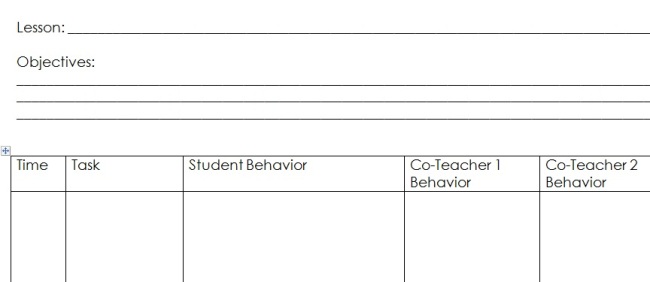Weren’t able to make the session on co-teaching on Saturday, May 3 at Washington English Center? Here are some ideas to plan and deliver lessons effectively with a co-teacher.
By Ashley Lipps
Co-teaching is when two teachers take a substantive role in the classroom. This model is different from teaching arrangements that see one teacher as the lead and the other as the assistant. Even if you are a new teacher and you rely on a more experienced co-teacher for a lot of guidance and ideas (or vice versa) both teachers take responsibility and should have the opportunity to plan and lead lessons.
There are many ways co-teaching can be realized, and Friend & Cook (2007) have observed six co-teaching arrangements. They were looking at the context of elementary to high school ESL, which usually sees an ESL teacher co-teaching with a content teacher (science teacher, language arts teacher, etc.). Although our situation is a little different at Washington English, it’s still a useful place to start thinking about what co-teaching can look like.
One teach, one observe
In this arrangement, one teacher leads the class while the other sits and observes students. The teacher who isn’t leading the class should still have a job to do. They can listen and make note of common student errors to review later in the class. They can correct the homework. They can sit with a student who needs extra help and work with them through the lesson.
One teach, one drift
In this arrangement, one teacher leads the class while the other circulates around the room, helping students are needed.
Station teaching
In this arrangement, there are three or more stations in the classroom, each with a distinct task. In groups, students circulate from one station to the next. Each teacher leads a station, and at the third and any additional stations, students work independently.
Parallel Teaching
In this arrangement, the class is split in two equal groups. One group works with one teacher and the other group with the other teacher. This arrangement is popular at Washington English Center for language practice activities and conversation circles. It allows students to do an activity and interact with a group, but a more intimate group so each student has more opportunity to speak and practice.
Of course, these half group conversation circles only work if the teacher can manage to not talk too much and dominate the conversation. This is a common pitfall because I think as English teachers most of us are naturally chatty people! But it’s up to the students to converse, share their opinion, and steer the direction of the conversation. The teacher is just there to answer language questions as needed and ask open-ended questions if the conversation lulls.
Alternative Teaching
This arrangement is similar to parallel teaching, the class is split into two groups- but one group has the majority of the students while the other is a small group of students who need more focused attention. This arrangement is helpful if you’ve got a small number of students who really need extra help and support.
A question that came up- How do you arrange the students so that those who need extra help don’t feel singled out? With parallel teaching this isn’t an issue because both groups do the same activity in the same way. But with alternative teaching, you want students who are farther ahead in one group, and those who need more work in a different group.
Often students know that they need a bit of help in one area, so they’re pretty understanding, and it’s not a concern. But if you’re worried about it, here’s my suggestion- Hand out cards of two different colors. It can be colored paper cut into cards, colored index cards, red and black playing cards, etc. It’s easy to make it look like you’re randomly handing out cards when really you’re handing out the colors intentionally. The stronger students get one color, and the weaker students get a different color. Then you can say students with this color, go work with this teacher. Then it’s about the card, not the student.
Team Teaching
In this arrangement, both teachers are simultaneously leading a class. This arrangement is very useful when teachers are modeling an activity. It can also be used when reviewing an activity that students have done in small groups or pairs, both teachers can elicit responses from students about what they discussed is their groups.
Recommendations
So which arrangement is best? There’s no one answer because it really depends on what the class is doing at the moment. However, Friend (2008) did write a few recommendations for using these arrangement, and she suggested using the station/parallel/alternative teaching arrangements more often than one teach, one observe/drift.
One reason to not rely too heavily on one teach, one observe is that often, I believe, it’s used as a cover of a slightly different arrangement- one teach, one just sit there! If one teacher leads, while the other is sitting observing, the observer really should have a job to do.
But another reason to recommend limited use of these arrangements is that one teach, one drift/observe arrangements are quite teacher-centered. These models work best when you are presenting new information. If you’re presenting new grammar, it can be best to just have one teacher explain it. However, this explanation shouldn’t take very long. The sooner you can get the class practicing the new grammar themselves, the better.
One question that came up Saturday- What if you’re explaining grammar and students just seem totally confused. I think the best answer to that concern is- that’s okay! If your co-teacher can explain the grammar in a unique way, then he or she can take a stab at presenting the new information, but if the students STILL seem confused, don’t worry. Grammar explanations are pretty confusing. The best way for students to understand how to use the grammar is to practice, practice, practice. So spend no more than 5 or 10 minutes explaining, and then start the practice activities and count on context and examples to clarify confusing grammar.
So you don’t want to spend much time with a teacher centered classroom. For me, it’s helpful to think of a seventh arrangement that I want to call “Both drift.” You want to spend as much time as possible in small group work and pair work, and after a small group activity has been set up, students talk in pairs or groups, and teachers circulate, helping out as needed. I say both drift, because it’s good to give students time when a teacher isn’t working with their group, especially if you have students who tend to talk to the teacher and not each other.
Whatever arrangements you and your co-teacher use, another of Friend’s recommendations is key- Discuss and plan beforehand to ensure that both teachers have a role. Plan explicitly what you will do, what your co-teacher will do, and communicate with your co-teacher. Even if you see both teachers team teaching and doing the same things, discuss this with your co-teacher so you’re both on the same page.
I have a lesson planning template that I want to recommend to get you started. This template asks you to describe your lesson in columns. Click the link to download the template:
WEC Lesson Plan Template for 2 Co-teachers
Time- How much time will it take? It’s difficult to predict, but jot down an estimate of how long an activity will take and by what time you expect to have finished, i.e. 15 minutes/7:30pm. Then if it’s 7:30pm and you’re still working, at least you know you’re behind and can decided whether to continue and make up time later or to wrap up the activity.
Task- What activity the class will do, page numbers, etc. I also find it helpful to write “whole class,” “small group,” “pair work,” and “individual work.” Then I can see at a glance if I’ve got enough small group and pair activities.
Student behavior- What will the students do? The students should be doing the most in class, so you want to fill up this column.
Co-teacher 1 behavior & Co-teacher 2 behavior- In these columns, write what each teacher will do. It should then be obvious if one teacher is not being utilized for an extended period of time, and you can reassess the activity to take advantage of both teachers.
I find myself writing across the co-teacher 1 & 2 columns when I want both of us to lead or do the same thing. Even if you’re not differentiating the co-teacher tasks, it’s helpful to write these out. Then your co-teacher knows what to do and they know that you want them to do it. If you write, “read questions and ask volunteers to tell the group what they discussed with their partners” then your co-teacher will know that they aren’t stepping on your toes if they do this.
Many of the issues that come up in co-teaching can be addresses with proper planning. Whether you plan with your co-teacher or each plans part of the lesson at home, be explicit and communicate with your co-teacher about what the students will do, what you’ll do, and what your co-teacher will do.
References
Friend, M. & Cook, L. (2007). Interactions: Collaboration skills for school professionals (5th edition). Boston: Allyn and Bacon.
Friend, M. (2008). Co-Teaching: A simple solution that isn’t simple after all. Journal of Curriculum and Instruction, 2(2), 9-19.

